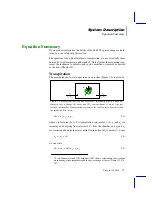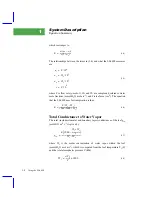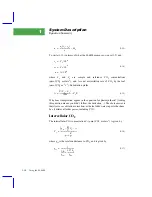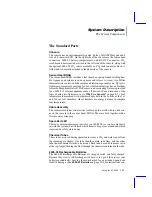
System Description
The System Components
Using the LI-6400
1-13
The Standard Parts
Console
The console has an environmentally sealed, 64-key, full ASCII keypad and 8
line
´
40 character LCD. On the right side of the console are the sensor head
connectors, 6400-03 battery compartments, and RS-232C connector. CO
2
scrubber and desiccant tubes attach to the left side of the console, along with
the optional 6400-01 CO
2
source assembly or CO
2
tank connector block. A
field stand is normally attached to the underside of the console.
Sensor Head/IRGA
The sensor head/IRGA includes a leaf chamber, spring-loaded latching han-
dle (squeeze and release to open, squeeze and release to close), two Peltier
thermoelectric coolers, and the sample and reference gas analyzers. Up to two
light measurements are provided for: most leaf chamber tops have a Gallium
Arsenide Phosphide (GaAsP) PAR sensor, and a mounting fixture is provided
for a 9901-013 external quantum sensor, if desired. (For a discussion of the
logic of using two light sensors, see
temperature is measured with a thermocouple held in the bottom of the 2x3
and 2x6 cm leaf chambers; other chambers use energy balance to compute
leaf temperature.
Cable Assembly
The cable assembly has two electrical cables and two air flow hoses, and con-
nects the console to the sensor head / IRGA. These are held together with a
flexible, outer wrapping.
Spare Parts Kit
This box contains replacement parts for your LI-6400. As you become famil-
iar with the system you will learn which items to keep close at hand and which
items can be safely stored away.
Chemical Tubes
These tubes are used during operation to remove CO
2
and water vapor from
the incoming air stream. One tube should contain soda lime, and the other
tube should contain Drierite, a desiccant. Each tube has an adjustment valve
at the top for partitioning the flow through the chemical contained in the tube.
6400-03 Rechargeable Batteries
The 6400-03 Rechargeable Batteries are shipped tested and fully charged.
Because they slowly self-discharge with time, it is a good idea to test your
batteries periodically. Leaving them discharged for an extended period can
result in damage. (See
Summary of Contents for LI-6400
Page 1: ...Using the LI 6400 Portable Photosynthesis System ...
Page 15: ...Part I The Basics ...
Page 16: ......
Page 174: ...Making Measurements Answers to Questions 4 56 Using the LI 6400 4 ...
Page 175: ...Part II Useful Details ...
Page 176: ......
Page 200: ...Standard Tools Power ON Hooks 5 24 Using the LI 6400 5 ...
Page 214: ...Real Time Data Real Time Graphics 6 14 Using the LI 6400 6 ...
Page 234: ...Environmental Control Light Control 7 20 Using the LI 6400 7 ...
Page 244: ...Light Sensor Considerations Gallium Arsenide Phosphide GaAsP Sensor 8 10 Using the LI 6400 8 ...
Page 288: ...Data Logging Making Your Own AutoPrograms 9 44 Using the LI 6400 9 ...
Page 289: ...Part III Working With Files ...
Page 290: ......
Page 312: ...The LPL File System Troubleshooting 10 22 Using the LI 6400 10 ...
Page 340: ...Downloading Files Using a Data Capture Program 11 28 Using the LI 6400 11 ...
Page 375: ...Part IV Configuration Issues ...
Page 376: ......
Page 420: ...Defining User Variables Old Style vs New Style 15 18 Using the LI 6400 15 ...
Page 454: ...Using an Energy Balance Further Reading 17 12 Using the LI 6400 17 ...
Page 455: ...Part V Maintenance Troubleshooting ...
Page 456: ......
Page 572: ...Troubleshooting Useful Information 20 46 Using the LI 6400 20 ...
Page 593: ...Part VI Programming ...
Page 594: ......
Page 622: ...Programming with LPL Compiler Directives 22 28 Using the LI 6400 22 ...
Page 846: ...Index I 16 Using the LI 6400 ...
















































